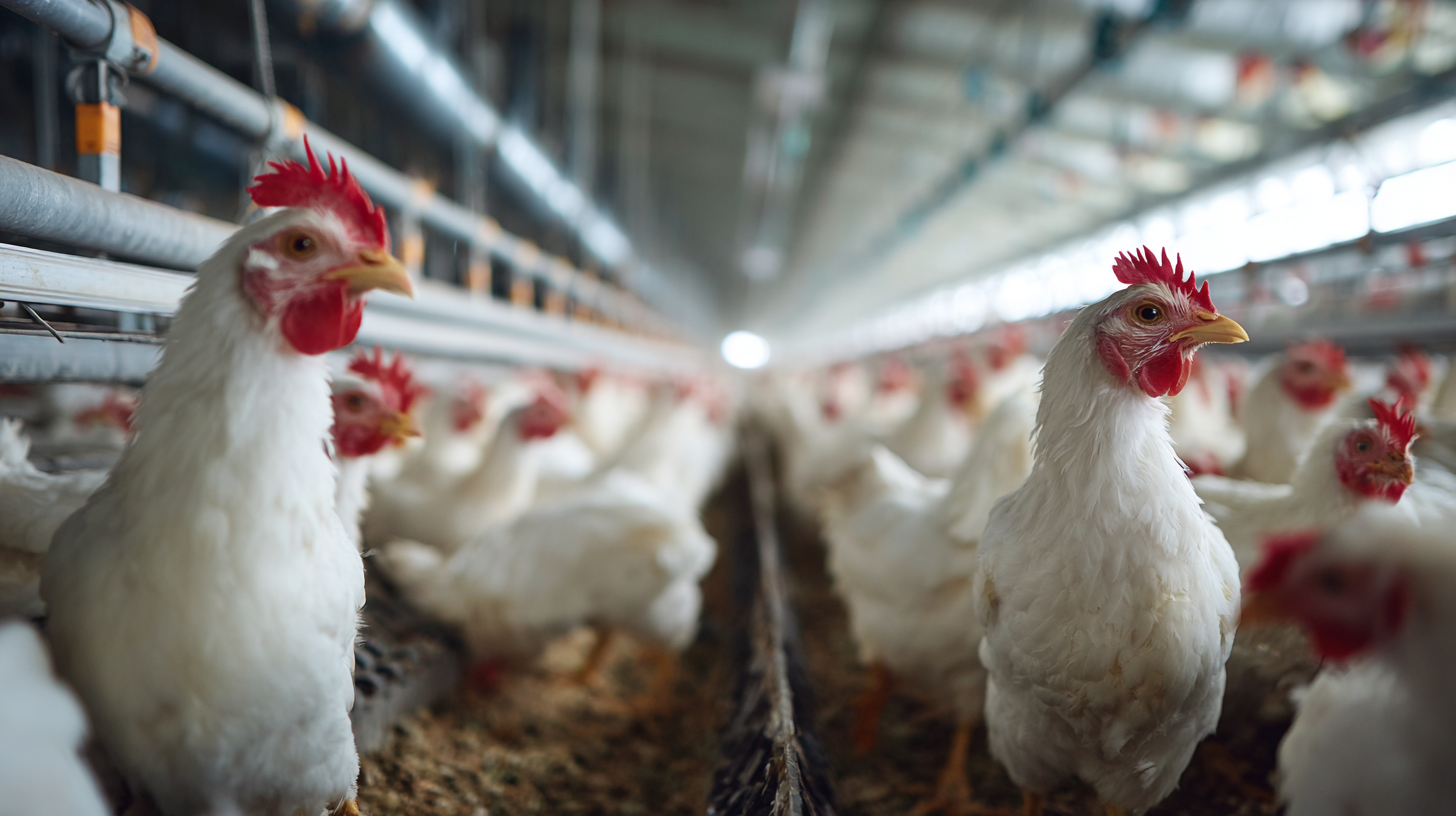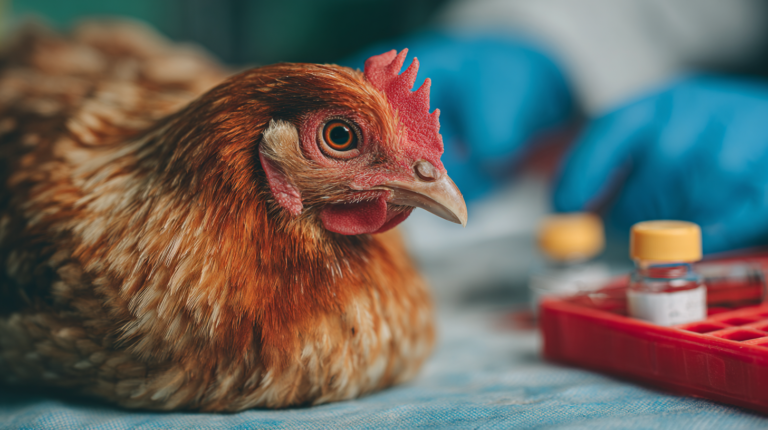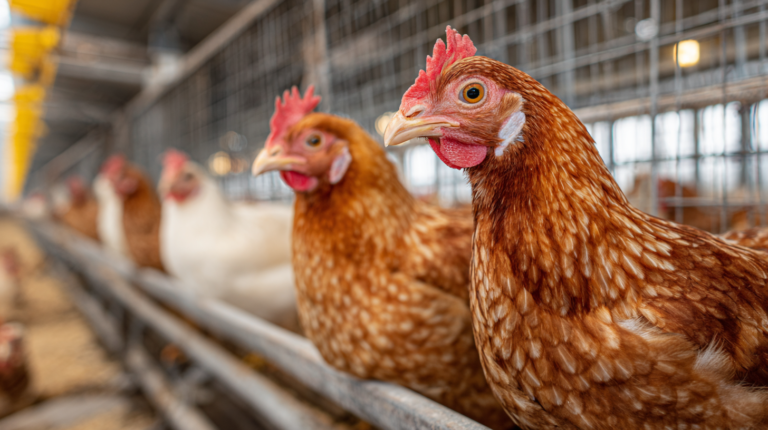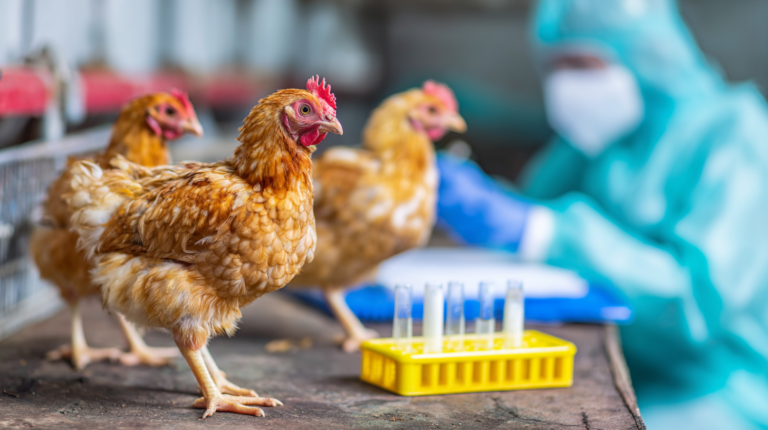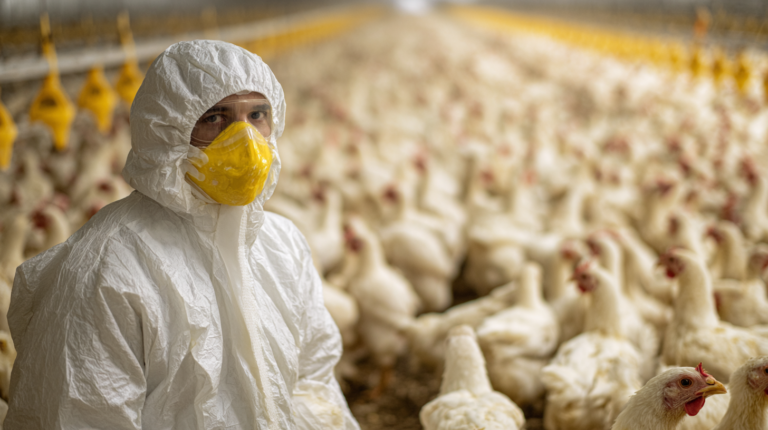Discover 5 powerful strategies to prevent ammonia poisoning in poultry farms. Learn symptoms, causes, and expert veterinary tips to protect your flock’s health and productivity.
Table of Contents
Ammonia poisoning in poultry farms represents one of the most insidious threats to flock health, productivity, and profitability that many farmers face daily. This colorless, pungent gas silently accumulates in poorly ventilated coops and barns, creating a toxic environment that can devastate entire flocks within days. Unlike sudden disease outbreaks or predator attacks, ammonia poisoning develops gradually, making it particularly dangerous because symptoms often go unnoticed until significant damage has already occurred.
The financial impact of ammonia toxicity extends far beyond immediate bird mortality. Affected poultry experience reduced egg production, compromised immune systems, respiratory distress, and stunted growth rates that can cost farmers thousands of dollars in lost revenue. According to recent veterinary studies, even low-level chronic ammonia exposure can reduce egg production by up to 15% and increase susceptibility to secondary infections by 40%.
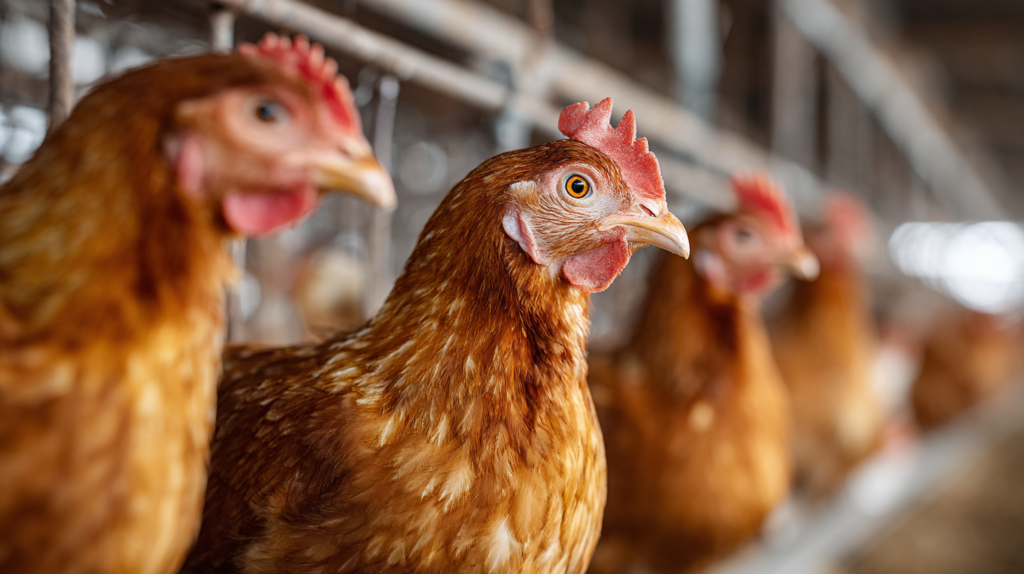
Understanding how to identify, prevent, and manage ammonia poisoning in poultry farms is essential for anyone raising chickens, turkeys, ducks, or other domestic fowl. Whether you’re managing a small backyard flock or operating a commercial poultry operation, the principles of ammonia control remain consistent and critically important for maintaining healthy, productive birds.
Understanding Ammonia Poisoning in Poultry:
| Ammonia Level (ppm) | Safety Status | Health Effects | Performance Impact | Immediate Action Required |
|---|---|---|---|---|
| 0-10 | Optimal | No adverse effects, birds thrive | Maximum productivity | Continue monitoring |
| 10-25 | Acceptable | Minimal stress, good health maintained | 95-100% normal performance | Regular ventilation checks |
| 25-50 | Caution | Respiratory irritation, eye watering | 80-90% performance reduction | Increase ventilation immediately |
| 50-75 | Dangerous | Severe respiratory distress, coughing | 60-80% performance loss | Emergency ventilation measures |
| 75+ | Critical | Life-threatening, permanent damage possible | Severe mortality risk | Evacuate birds immediately |
Ammonia poisoning occurs when birds are exposed to elevated levels of ammonia gas, which forms naturally through the decomposition of nitrogen-containing compounds in poultry waste. This toxic gas accumulates in enclosed spaces where birds live, creating a hostile environment that attacks their respiratory systems, eyes, and overall health.
The chemical process begins when bacteria break down uric acid and other nitrogen compounds found in bird droppings, releasing ammonia gas into the air. Under normal circumstances, proper ventilation would remove this gas before it reaches dangerous concentrations. However, when ventilation is inadequate or environmental conditions prevent proper air circulation, ammonia levels can quickly reach toxic thresholds.
Poultry are particularly vulnerable to ammonia poisoning because they spend most of their time close to the ground where ammonia concentrations are highest. The gas is heavier than air and tends to accumulate in lower areas of coops and barns, creating a toxic layer that birds cannot escape. Additionally, birds’ unique respiratory anatomy makes them more susceptible to airborne toxins than mammals.
Veterinary research indicates that ammonia concentrations above 25 parts per million (ppm) begin to cause physiological stress in poultry. At 50 ppm, birds experience significant respiratory irritation and reduced performance. Concentrations exceeding 100 ppm can cause severe respiratory damage, corneal ulcers, and potentially fatal complications within hours of exposure.
The insidious nature of ammonia poisoning makes it particularly challenging to detect early. Unlike sudden illness or injury, ammonia toxicity develops gradually, with subtle symptoms that farmers might attribute to other causes. By the time obvious signs appear, significant damage may have already occurred to the birds’ respiratory systems, immune function, and overall health.
Recognizing the Warning Signs: Early Detection Saves Lives
Early recognition of ammonia poisoning symptoms can mean the difference between a minor setback and a catastrophic loss. Experienced poultry veterinarians emphasize that successful management depends on identifying problems before they become severe enough to cause permanent damage or death.
The earliest indicators of ammonia exposure often involve changes in bird behavior rather than obvious physical symptoms. Birds may become less active, spend more time sitting or resting, and show decreased interest in food and water. These behavioral changes occur because ammonia irritates the respiratory tract, making normal activities more difficult and uncomfortable.
Respiratory symptoms typically appear as the first obvious physical signs of ammonia poisoning. Birds may exhibit increased respiratory rate, open-mouth breathing, or audible breathing sounds. In severe cases, birds may extend their necks and gasp for air, indicating severe respiratory distress. Chronic exposure can lead to permanent damage to the respiratory tract, including scarring and reduced lung function.
Eye irritation represents another early warning sign that veterinarians use to assess ammonia exposure. Birds may show excessive tearing, swollen eyelids, or corneal cloudiness. In severe cases, ammonia can cause corneal ulcers that may lead to permanent vision impairment or blindness. The eyes are particularly sensitive to ammonia because the gas readily dissolves in tear film, creating a concentrated acidic solution that damages delicate eye tissues.
Performance indicators provide additional clues about ammonia exposure levels. Egg production may decline gradually, with eggs showing reduced shell quality, abnormal shapes, or decreased size. Growth rates in young birds may slow significantly, and feed conversion efficiency typically decreases as birds expend more energy dealing with respiratory stress.
Secondary infections often complicate ammonia poisoning because the gas damages the respiratory tract’s natural defense mechanisms. Birds exposed to chronic ammonia are more susceptible to bacterial and viral respiratory infections, which can create a cycle of declining health that becomes increasingly difficult to break.
The Five Most Powerful Prevention Strategies
| Prevention Strategy | Implementation Method | Expected Results | Priority Level | Cost Impact |
|---|---|---|---|---|
|
1
Comprehensive Ventilation Systems
Install proper air circulation and exhaust systems
|
Install minimum air exchange rates, use automatic ventilation controllers, ensure proper fan placement | Reduces ammonia by 60-80%, maintains optimal air quality | Essential | High initial, low ongoing |
|
2
Optimal Litter Management
Maintain dry, absorbent bedding materials
|
Regular litter turning, moisture monitoring, proper drainage, appropriate litter depth | Reduces ammonia production by 40-60%, improves bird comfort | Essential | Medium ongoing costs |
|
3
Population Density Control
Maintain appropriate stocking rates per square foot
|
Follow industry guidelines for bird density, allow adequate space per bird, avoid overcrowding | Reduces ammonia buildup by 30-50%, decreases stress levels | Important | Revenue impact consideration |
|
4
Strategic Feeding & Water Management
Optimize nutrition and prevent water waste
|
Balanced protein levels, proper feeder design, leak-proof waterers, feeding schedules | Reduces nitrogen waste by 25-40%, improves overall health | Important | Low to medium costs |
|
5
Regular Monitoring Protocols
Establish systematic inspection routines
|
Daily ammonia testing, visual inspections, record keeping, alarm systems | Early detection prevents major issues, ensures compliance | Beneficial | Low ongoing costs |
1. Implement Comprehensive Ventilation Systems
Proper ventilation represents the single most effective strategy for preventing ammonia poisoning in poultry farms. A well-designed ventilation system removes ammonia-laden air while providing fresh oxygen and maintaining appropriate temperature and humidity levels throughout the facility.
Natural ventilation systems rely on wind and temperature differences to create air movement through strategically placed openings. These systems work best in moderate climates where extreme temperatures don’t require significant environmental control. However, natural ventilation alone often proves insufficient during periods of high ammonia production or adverse weather conditions.
Mechanical ventilation systems use fans and air exchange equipment to actively remove contaminated air and bring in fresh air. These systems provide more consistent air quality control but require electrical power and regular maintenance. Modern mechanical systems often include sensors that automatically adjust fan speeds based on ammonia levels, temperature, and humidity.
The key to effective ventilation lies in creating proper air circulation patterns that remove ammonia at its source near the floor while avoiding drafts that could stress birds. Air should enter the facility at multiple points, circulate throughout the space, and exit through outlets positioned to carry away the highest concentrations of ammonia.
Veterinary experts recommend maintaining air exchange rates of 0.5 to 1.0 cubic feet per minute per pound of bird body weight during moderate weather conditions. During periods of high ammonia production or extreme temperatures, air exchange rates may need to increase to 2.0 cubic feet per minute per pound to maintain safe air quality.
2. Maintain Optimal Litter Management Practices
Litter management directly impacts ammonia production and represents one of the most controllable factors in preventing toxic gas accumulation. The type, moisture content, and management practices surrounding litter materials significantly influence ammonia generation rates.
Selecting appropriate litter materials forms the foundation of effective ammonia control. Wood shavings, rice hulls, and peanut shells provide excellent absorption and create environments that discourage ammonia-producing bacteria. These materials should be dry, absorbent, and free from mold or other contaminants that could contribute to air quality problems.
Moisture management proves critical because bacteria require specific moisture levels to convert nitrogen compounds into ammonia gas. Litter moisture content should remain between 20-30% for optimal ammonia control. Higher moisture levels accelerate bacterial activity and ammonia production, while excessively dry litter can create dust problems that irritate birds’ respiratory systems.
Regular litter monitoring and maintenance prevent the accumulation of wet spots where ammonia production accelerates. Areas around waterers, feeding stations, and corners where birds congregate require particular attention. Spot-cleaning wet areas and adding fresh litter material can significantly reduce localized ammonia production.
The practice of “litter caking” or allowing manure to accumulate in thick layers should be avoided. While some farmers believe this approach reduces labor, it actually creates anaerobic conditions that promote ammonia production. Instead, litter should be stirred regularly to promote aerobic decomposition and prevent the formation of ammonia-producing layers.
3. Control Population Density and Stocking Rates
Overcrowding represents one of the most common causes of ammonia poisoning in both commercial and backyard poultry operations. When too many birds occupy a given space, waste production exceeds the environment’s capacity to process nitrogen compounds safely, leading to rapid ammonia accumulation.
Proper stocking density calculations must consider bird size, growth rates, and production systems. Commercial broiler operations typically allow 0.5 to 1.0 square feet per bird, while laying hens require 1.5 to 2.0 square feet per bird in confined housing systems. These calculations assume adequate ventilation and litter management practices.
Free-range and pastured systems generally allow higher stocking densities because birds spend significant time outdoors where ammonia dissipation occurs naturally. However, even these systems require careful monitoring because birds typically concentrate in shelter areas during adverse weather, creating temporary high-density conditions.
The relationship between stocking density and ammonia production isn’t linear. Doubling the bird population in a given space typically increases ammonia production by more than double because waste concentrates in smaller areas and overwhelms natural dissipation mechanisms. This exponential relationship makes slight reductions in stocking density particularly effective for ammonia control.
Seasonal adjustments to stocking density help manage ammonia production during periods of reduced air circulation. Winter housing may require lower stocking densities to compensate for reduced ventilation, while summer housing can often accommodate higher densities due to increased air movement and outdoor access.
4. Implement Strategic Feeding and Water Management
Dietary management influences ammonia production through its impact on nitrogen excretion and waste characteristics. Birds fed properly balanced diets with appropriate protein levels produce less nitrogenous waste, reducing the raw materials available for ammonia formation.
Protein levels should match birds’ specific nutritional requirements without excess. Overfeeding protein leads to increased nitrogen excretion and higher ammonia production. Modern poultry nutrition emphasizes phase feeding, where protein levels are adjusted based on birds’ changing requirements throughout their production cycle.
Feed additives can significantly impact ammonia production. Probiotics and beneficial bacteria supplements help maintain healthy gut microbiomes that improve protein digestion and reduce nitrogenous waste. Organic acids added to feed can lower gut pH, reducing ammonia production in the intestinal tract.
Water management proves equally important because hydration status affects waste consistency and ammonia production. Birds should have constant access to clean, fresh water to maintain proper hydration and produce well-formed waste that generates less ammonia. Leaking waterers create wet spots in litter that accelerate ammonia production and should be repaired immediately.
The timing of feeding and watering can influence ammonia production patterns. Providing fresh feed and water early in the day encourages birds to consume nutrients when their digestive systems are most efficient, reducing waste production and improving overall health.
5. Establish Regular Monitoring and Maintenance Protocols
Consistent monitoring and maintenance protocols provide the foundation for long-term ammonia control. These systems allow farmers to identify problems before they become severe and maintain optimal environmental conditions throughout the production cycle.
Ammonia monitoring should include both sensory assessment and quantitative measurement. The human nose can detect ammonia at concentrations around 5-10 ppm, but birds begin experiencing stress at much lower levels. Professional-grade ammonia meters provide accurate readings and should be used regularly to assess air quality.
Daily visual inspections should include checking litter conditions, observing bird behavior, and assessing ventilation system function. Wet spots in litter, unusual bird behavior, or equipment malfunctions require immediate attention to prevent ammonia accumulation.
Weekly deep cleaning and maintenance activities should include stirring or replacing litter in problem areas, cleaning waterers and feeders, and checking ventilation equipment. These regular activities prevent the gradual accumulation of conditions that promote ammonia production.
Seasonal maintenance protocols ensure that systems remain effective throughout changing weather conditions. Spring cleaning should include deep litter replacement, ventilation system inspection, and equipment maintenance. Fall preparation should focus on insulation, heating system checks, and ventilation adjustments for winter housing.
Record-keeping systems help track ammonia levels, bird performance, and environmental conditions over time. These records provide valuable information for identifying patterns and making informed management decisions.
This comprehensive infographic illustrates the five prevention strategies in a visually appealing format, showing cross-sections of properly ventilated coops, litter management techniques, proper bird spacing, feeding schedules, and monitoring equipment placement. Each section includes specific measurements and visual indicators to help farmers implement these strategies effectively.
Environmental Factors That Influence Ammonia Production
| Time Phase | Clinical Signs | Severity Level | Immediate Actions | Treatment Protocol | Recovery Timeframe |
|---|---|---|---|---|---|
| 0-6 Hours | Eye irritation, mild respiratory distress, reduced activity | Mild | Increase ventilation, remove wet litter | Fresh air access, monitor closely, ensure adequate water | 6-12 hours |
| 6-12 Hours | Coughing, gasping, eye discharge, reduced feed intake | Moderate | Emergency ventilation, isolate affected birds | Supportive care, electrolyte solutions, veterinary consultation | 1-3 days |
| 12-24 Hours | Severe respiratory distress, mouth breathing, weakness | Severe | Evacuate birds immediately, contact veterinarian | Oxygen therapy, anti-inflammatory drugs, intensive monitoring | 1-2 weeks |
| 24-48 Hours | Neurological signs, convulsions, coma, high mortality | Critical | Emergency evacuation, immediate veterinary intervention | Intensive care, IV fluids, corticosteroids, supportive therapy | 2-4 weeks* |
| 48+ Hours | Permanent organ damage, chronic respiratory issues | Critical | Long-term management required | Ongoing supportive care, environmental modifications | Permanent effects |
| Recovery | Gradual improvement in appetite, activity, breathing | Monitoring | Maintain optimal environment, prevent reoccurrence | Nutritional support, probiotics, gradual return to normal routines | Variable |
Understanding environmental factors that affect ammonia production helps farmers anticipate and prevent dangerous accumulations. Temperature, humidity, air circulation, and seasonal changes all play significant roles in determining how quickly ammonia levels rise in poultry facilities.
Temperature significantly influences bacterial activity and ammonia production rates. Higher temperatures accelerate bacterial metabolism, leading to faster conversion of nitrogen compounds into ammonia gas. During summer months, ammonia production can increase by 50-100% compared to winter levels, requiring enhanced ventilation and more frequent litter management.
Humidity levels affect both ammonia production and its concentration in the air. High humidity promotes bacterial growth and ammonia formation while reducing the air’s capacity to hold moisture, leading to wet litter conditions. Conversely, extremely low humidity can cause excessive dust formation, which irritates birds’ respiratory systems and makes them more susceptible to ammonia damage.
Barometric pressure changes associated with weather systems can affect ammonia concentration in poultry facilities. Low pressure systems may reduce natural ventilation effectiveness, allowing ammonia to accumulate more rapidly. High pressure systems may improve air circulation but can also concentrate pollutants in closed systems.
Seasonal variations require adjusted management strategies. Spring often brings increased moisture from rain and melting snow, creating conditions that promote ammonia production. Summer heat accelerates bacterial activity and may reduce birds’ tolerance to ammonia exposure. Fall preparation must account for reduced natural ventilation as buildings are closed for winter. Winter housing typically requires the most careful balance between ventilation for air quality and heat conservation.
Geographic location influences ammonia management strategies. Coastal areas may experience higher humidity levels that promote ammonia production, while arid regions may face dust-related challenges that complicate air quality management. Mountain regions may experience rapid barometric pressure changes that affect ventilation effectiveness.
Health Consequences of Chronic Ammonia Exposure
The health impacts of chronic ammonia exposure extend far beyond immediate respiratory symptoms, creating long-term consequences that can permanently affect flock productivity and profitability. Understanding these effects helps farmers appreciate the importance of consistent ammonia control measures.
Respiratory system damage represents the most obvious consequence of ammonia exposure. Chronic exposure causes inflammation of the respiratory tract, including the trachea, bronchi, and air sacs. This inflammation reduces the efficiency of gas exchange and makes birds more susceptible to respiratory infections. In severe cases, permanent scarring can occur, reducing lung function for the remainder of the bird’s life.
Immune system suppression occurs when birds expend significant energy dealing with ammonia stress. The constant inflammatory response required to cope with ammonia exposure depletes immune resources, making birds more vulnerable to bacterial, viral, and parasitic infections. This immunosuppression can persist for weeks or months after ammonia exposure ends.
Eye damage from ammonia exposure can range from minor irritation to permanent vision impairment. Corneal ulcers may develop in severe cases, potentially leading to blindness. Even minor eye irritation can affect birds’ ability to locate food and water, impacting their overall health and productivity.
Reproductive performance suffers significantly under chronic ammonia exposure. Laying hens may experience reduced egg production, decreased shell quality, and increased mortality rates. Breeding birds may show reduced fertility rates and decreased hatch rates, impacting the next generation’s productivity.
Growth rate reductions in young birds exposed to ammonia can have lifelong consequences. Stunted growth during critical development periods may never be fully recovered, resulting in smaller mature birds with reduced productive capacity. This is particularly problematic in commercial broiler operations where growth rate directly impacts profitability.
Stress-related behaviors may develop in birds exposed to chronic ammonia, including increased aggression, feather pecking, and cannibalism. These behaviors can spread throughout the flock and create additional management challenges that persist even after air quality improves.
Emergency Response Protocols for Ammonia Poisoning
When ammonia poisoning occurs, quick and decisive action can save lives and minimize long-term damage. Having established emergency protocols ensures that farmers can respond effectively during crisis situations.
Immediate assessment should begin with removing affected birds from the contaminated environment. Birds showing severe respiratory distress, eye damage, or inability to stand require immediate veterinary attention. Mildly affected birds may recover with improved air quality and supportive care.
Ventilation enhancement represents the most critical immediate intervention. All available ventilation systems should be activated to maximum capacity, and additional fans or air movers should be brought in if available. Opening doors and windows can provide temporary relief, but care must be taken to avoid creating drafts that could stress already compromised birds.
Litter management becomes crucial during emergency situations. Wet or heavily contaminated litter should be removed immediately, even if complete replacement isn’t possible. Adding fresh, dry litter material can help absorb moisture and reduce continued ammonia production.
Veterinary consultation should be sought immediately when ammonia poisoning is suspected. Veterinarians can provide specific treatments for respiratory distress, eye damage, and secondary infections. They can also help assess the extent of damage and provide guidance on long-term management strategies.
Supportive care for affected birds includes providing easy access to fresh water and high-quality feed. Electrolyte supplements may help birds recover from stress, while vitamins A and C can support immune function and tissue repair. Reducing stocking density temporarily may help birds recover more quickly.
Documentation of the incident provides valuable information for preventing future occurrences. Recording ammonia levels, environmental conditions, and bird symptoms helps identify contributing factors and improve management protocols.
Long-term Management Strategies for Sustainable Operations
Sustainable ammonia control requires integrated management approaches that address all contributing factors while maintaining economic viability. These strategies focus on creating systems that prevent problems rather than simply responding to them.
Facility design modifications can significantly improve ammonia control in existing operations. Installing additional ventilation capacity, improving insulation, and modifying air flow patterns often provide long-term solutions to chronic ammonia problems. These improvements typically pay for themselves through improved bird performance and reduced mortality.
Breeding program considerations can help develop birds that are more resistant to ammonia exposure or produce less nitrogenous waste. Selecting for birds with improved feed conversion efficiency reduces waste production, while breeding for respiratory health can improve ammonia tolerance.
Technology integration offers new opportunities for ammonia monitoring and control. Automated ventilation systems with ammonia sensors can adjust air flow in real-time, while remote monitoring systems allow farmers to track air quality from anywhere. These technologies are becoming increasingly affordable and accessible for operations of all sizes.
Staff training and education ensure that all personnel understand the importance of ammonia control and know how to implement prevention strategies effectively. Regular training sessions and written protocols help maintain consistency in management practices.
Economic analysis of ammonia control measures helps farmers understand the return on investment for prevention strategies. While some interventions require initial capital investment, the long-term benefits typically far exceed the costs through improved productivity and reduced mortality.
Regulatory Compliance and Industry Standards
Understanding regulatory requirements and industry standards for ammonia control helps farmers ensure compliance while maintaining optimal air quality. These standards continue to evolve as research provides new insights into ammonia’s effects on animal welfare and environmental impact.
Environmental regulations increasingly address ammonia emissions from poultry operations. The Environmental Protection Agency and state environmental agencies may require monitoring and reporting of ammonia levels, particularly for larger operations. Understanding these requirements helps farmers avoid regulatory problems while maintaining good air quality.
Animal welfare standards from organizations like the American Humane Association and United Egg Producers include specific requirements for air quality in poultry facilities. These standards typically specify maximum ammonia concentrations and require regular monitoring and documentation.
Food safety regulations indirectly address ammonia control through requirements for healthy animals and sanitary conditions. Poor air quality can increase disease risk and compromise food safety, making ammonia control an important component of comprehensive food safety programs.
Industry certification programs often include air quality requirements that exceed regulatory minimums. These programs help farmers demonstrate their commitment to animal welfare and environmental stewardship while potentially accessing premium markets.
International trade requirements may include animal welfare certifications that address air quality management. Farmers exporting products or seeking international certifications must understand these requirements and implement appropriate management systems.
Frequently Asked Questions
Everything you need to know about ammonia poisoning in poultry farms
No questions found matching your search.
Try different keywords or browse all questions above.For more expert pet care tips and product recommendations, visit BlithePet.com — your trusted source for pet wellness.
Conclusion
Ammonia poisoning in poultry farms represents a serious but preventable threat to flock health and productivity. The five powerful prevention strategies outlined in this article provide a comprehensive approach to maintaining safe air quality: implementing proper ventilation systems, maintaining optimal litter management, controlling population density, managing feeding and watering practices, and establishing regular monitoring protocols.
Success in preventing ammonia poisoning requires consistent attention to all contributing factors rather than relying on any single intervention. The investment in proper prevention measures typically pays significant dividends through improved bird health, increased productivity, and reduced mortality rates.
Early detection and prompt response remain crucial for minimizing the impact of ammonia exposure when it does occur. By understanding the warning signs and having emergency protocols in place, farmers can protect their flocks and maintain sustainable operations.
The long-term benefits of effective ammonia control extend beyond immediate health improvements to include enhanced animal welfare, regulatory compliance, and improved profitability. As consumer awareness of animal welfare issues continues to grow, farms with excellent air quality management will be better positioned to meet market demands and regulatory requirements.
Have a similar experience with your pet? Share it in the comments below!

